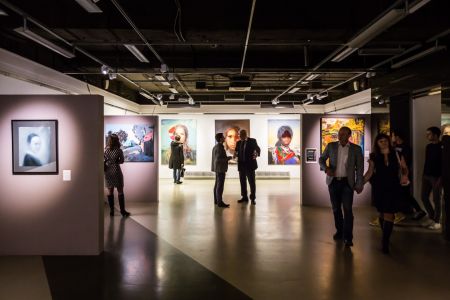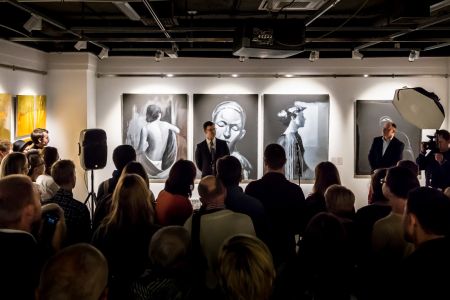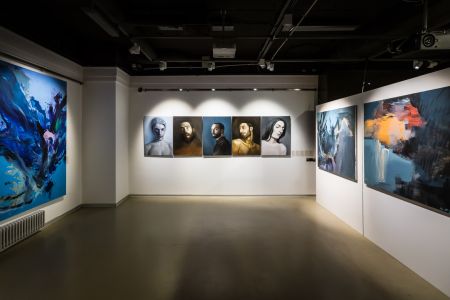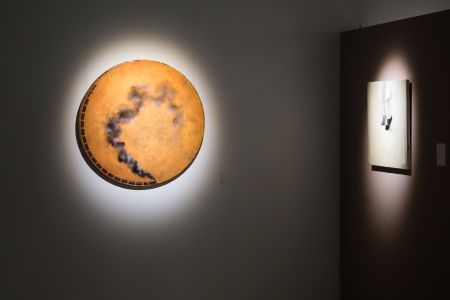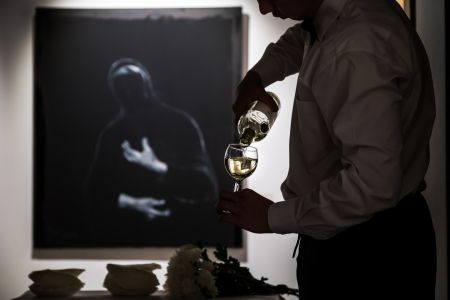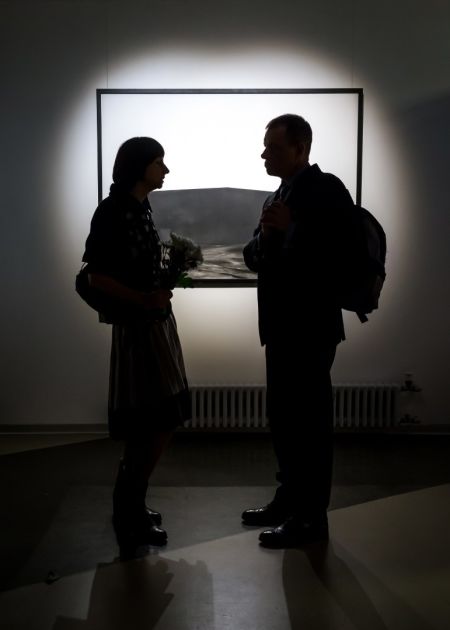Each painting in my collection has a story behind it and I cannot and would not pick out any single one: all of them are part of my life, a part of myself. With this site, I would like to open up to you a bit and to share with you things that interested and fascinated me for the last ten years, to make you aware of my exciting experience, my territory of joy and freedom.
Painting, one of the oldest mediums of fine arts has been impregnated with many contradictions, including its decline and recurrence during the last decades. Its position slowly shifted with the arrival of photography in 19th century, when modernism completely changed the attitude towards painting, focusing on its flatness instead of optical qualities. Later although announced to be dead, the painting resurrected again, persistently proving its importance and potential with a new force in 21th century. Nowadays painting can be almost everything — it has transformed into and merged with objects, sculptures, video works and performances, it has become eatable, touchable and wearable. This medium embodies extraordinary versatility and accommodates myriad explorations. If painting remains important today, it is because artists have sought for new ways of challenges when dealing with this medium, constantly diversifying the components of its production and presentation. In this article my interest is to point on the traditional tools of painting, — when it’s realized on canvas with the alluring qualities of color conquests, relations of proportion and surfaces, the patchiness and expression of a brush — all of which is a ground for imagination and endless inspiration.
The Latvian artists invited to be part of the exhibition In Endless Motion at Erarta museum in Saint Petersburg — Daiga Krūze, Līga Ķempe, Atis Jākobsons, Kaspars Perskis, Dace Dēliņa–Lipska and Ilgvars Zalāns, all have obtained their education from the Art Academy of Latvia and their work has been well known in the particular art circles for years. Although the local contemporary art scene has not been very favorable towards painting, those who are actively pursing this medium have proved that the painting has never lost its prominence in Latvia. It has been admired and even worshiped as one of the strongest medium of arts. What has kept the interest and why the painting that is based in the classical means of expression still has a huge attention? What are the qualities that never get old? When looking more closely at the artists’ work selected for this exhibition the questions that interest me are which qualities in painting the artists value, which conceptual and formal strategies, which modes of presentation and diffusion do they practice?
Painting is as object with many aspirations — it can be a gesture, a method and a training. It carries a historical legacy with all its burden and challenge. Artists often work by reviving and transforming the unconscious of contemporary culture. Hence in painting it’s always interesting how both the consciously chosen themes meet the unconscious, intuitive matters that reveal themselves in the material, surface, and colour. One of the artists whose work is very grounded in an intuitive mastery is Daiga Krūze. She tends to play with the surfaces of colour and brush stroke building abstract imaginary lands, taking the departure point in landscape and her surroundings that are not always based in the reality that we know but instead are coming from her emotional landscape revealing itself in a very intimate way. “When I paint, I immerse myself in the process so that the reality ceases to exist, I forget that I’m in the studio and I paint intuitively, without knowing what will happen next. At the beginning I paint the environment, a landscape, but later the landscape in my painting changes. I destroy it by playing with colour fields and lines. At the end I can say that I was there, inside my painting, looked around, walked there, left marks of my presence,” says Daiga. Visually her work is an organization of irregular areas, bigger and smaller spaces clashing and complementing, fighting and moving with each other. Three large scale paintings with the title Meeting point (2016), selected for the exhibition consist of the dark colour splashes, mainly blue, gray and black turbulently mashed together with interference of some pink and read. Their appearance resembles a thunderstorm when a sky is dealing with the fight of contrasting forces, going through different phases and color schemes. Her own words about the approach towards painting makes it very clear that the whole work is intuitively lead, encompassing this energy which is rather felt than explicitly explained. An intuitive lead that is quite common to many Latvian artists draws an attention to a more therapeutic practice of arts and many who engage with painting as viewers find it very important, even significant for the perception of an art piece.
For the exhibition the artists have been asked to work with a replica, an artwork from the past of Latvian classics, linking todays practice with the tradition, creating a dialogue, an answer or a conversation over time. Interestingly that Krūze has chosen to paint a replica of Voldemārs Irbe (1893 — 1944), who is well known Latvian classic that could be characterized as a master of capturing socially relevant images as well as landscapes and outskirts of the city, mostly in pastel colours. Using an expressive language, his paintings and drawings reveal an atmosphere and a mood focusing on the interaction of a man and nature in the first half of 20th century. His work brought some inspiration to Daiga due to the spatial qualities Irbe managed to achieve in his work, as well as the lightness and delicateness of the visual language he used.
Similarly to Daiga’s work an artist Ilgvars Zalāns deals with the expression of painting, which is one of the main tasks and also challenges of his practice. As a self-taught artist Ilgvars has engaged with many different approaches throughout his artistic career, favoring work that origins in action painting and performance, which he has been practicing since 2007. He produces paintings on canvas as well, that we see in the exhibition. Yet there’s a close link between his work on two-dimensional surface and an action painting, latter encompassing lots of spontaneity, impulsiveness, the wildness of colour and unexpectedness — these qualities he managed to transfer to the canvas as well. The works reveal the explosion of primal colours as splashes and dribbles on the surface, almost like a colour can has slipped out of the arms and fell on the canvas leaving the mess on it. However, there’s a certain composure in the works achieved by carefully choosing the relationship between the splashy surfaces and the background colour, for example it can be even gold, adding some decorativity and glittery effect to the piece.
Technique as a tool, a method and a quality that is embedded in the medium of painting seems to me an important mean to achieve a particular affect and elevate a painting to its appreciation. Even today when the painting has gone through different phases of rejection, especially suffering from constrains of neo-conceptual art, there are questions that are important to ask: how the layers of colour are applied, what relationships they tend to build, why a certain system of layering is important to the artist? What is achieved by colour and brush stroke, as well as other more technical methods?
An artist Līga Ķempe is particularly focused on these aspects in her work. Building her paintings with many layers of colour, scratching, glazing, smoothing, grinding, etc, she seeks for a certain glaze of the work. The paintings often literally become a polished piece of gem. Although her work might be put in the frame of a more decorative/salon art, its still carries thematically interesting aspects, for example focusing on women. There are often themes of relationship and life embodied in her work. At Erarta she represents a polyptych encompassing four seasons as life cycles by picturing a couple living and bearing love through various centuries. Additionally they are accompanied with musical pieces. The postcard type of painting is very direct in its content but at the same time provides with a greatly executed, visually appealing appearance.
An interest in a human figure and the image of it, the way it’s depicted is one of the reasons Līga chose to paint a replica of Latvian well acclaimed painter Boriss Bērziņš (1930 — 2002) who was a master in creative virtuosity. Her variations of Bērziņš one of the favorite themes, — curvy ladies’ backs corresponds with Līga’s interest in unconventional body of a woman, praising the ladies that are more realistic in their appearance than the ones conforming the beauty standards of the 21th century. Līga says that she is drawn by the archetypical, intuitive and sexual of a woman and the cycles that the woman has to engage with throughout the age, — the actions, intentions and knowledge that come with it. Yet it’s not only the notion and legacy of a woman depicted in a painting but also the figure as an object, the configuration itself that Līga is captivated with. As almost any artist she likes to explore the form, the contour, the line and relationships between them and the colours, as well as the result that might be achieved, — where lie the endless possibilities of working with these matters.
Another artist interested in the topic of womanhood is Dace Dēliņa–Lipska. Her paintings consist of multicolored, bright brush strokes revealing complex characters. There’s an interesting relationship between the momentum the artist tries to capture and the subject full of complicit contextual information. For example, in the recent series she explores the woman of suiti and seti, ethnic groups with long historical traditions living in Western part of Latvia and in Sothern part of Estonia and Russia. The focus is on their visual appearance — the posture, the clothe, the sturdiness of their faces — signifying the strength that is part of these women’s identity built throughout the centuries and kept till today. Artist’s work is about a woman who is supposed to play different roles complementing the society’s expectations at the same time keeping her own character and emotional stability. As we know the strength shall be worn to hide the weaknesses and vulnerabilities, which becomes part of the agenda in these paintings.
Dace continues to deal with the theme of woman in her choice of replica as well deciding to work with the painting of well known Latvian modernist artist Kārlis Padegs (1911 — 1940). His work “Okey, Baby” (1934) depicts a young and flirtatious woman (in another version of the same work Padegs paints an older face of the same character) who is looking at the viewer with wide huge eyes, a seductive smile and uncovered breast with a teasing nipple while in the background we see a man leaving the apartment, thus indicating on an intimate encounter that happened there. Seems that this work for Dace has been interesting due to the lusty nature. The young attractive lady is seen as an embodiment of youth, beauty and complacence, serving both as an object of desire and embodiment of power. For Dace’s style, which is full of enthusiastic painting advocating for women this is an interesting challenge to deal with, repainting the vigorous character, and adding another layer of interpretation to it.
In contract to Dace’s radiant painting Kaspars Perskis work bears a monochrome palette. He focuses mostly on a black, muddy colour and saturated gray as the main elements of his work. The opaque colours and rather rough brushwork yet tends to engage with a lyrical tone, most often capturing a figure of a human, in many paintings a woman. There’s a certain minimalism in his work, not much going on. The presence of a human figure rather builds a feeling, a condition of a mood instead of aiming for a mimetic reality. The minimal expression, reduced to the simpliness of footprint of a brush stroke and a layer of dark matte tone is the most captivating qualities of Kaspars work, deep and meditative. His choice to interpret Rūdolfs Pinnis (1902 — 1992) work in the replica, an artist who was a master of relationship of abstractness and almost geometric metaphysics, apparently points to Kaspars’ interest in the organization of elements and their arrangement on the canvas. He is focusing on the structural elements of painting, paying attention to the basics, looking for a clear and minimal expression as a departure point of everything else in the painting.
Atis Jākobsons’, the last one in the list of Latvian artists exhibited in the show, attention is pointed towards the explorations of a gender, looking for the liminal space that declares what is feminine and masculine. By playing with different images and characters, especially in the genre of portrait, he is experimenting with the perception of a viewer, trying to challenge our conjectures. Atis’ work in general masterly combines the explorations of selfies on social media like Instagram and Facebook, following today’s obsession with narcissistic image and his interest of traditions of painting and drawing refocusing again on the classical genre of portrait which for many centuries served as a mirror to the representation of both the social class, wealth, as well as self-expression and reflection. The production of his work always involves engagement with the captured people either carrying conversations with them, sketching and photographing, therefore gaining a certain access to their psychological map that is important aspect for the final picture. Practicing art in its traditional manner, including painting can be a certain tool for him to regain one to one communication with another human being, something we are slowly loosing in our lives due to technological impact.
The diversity these six painters show affirms that the painting today is so varied and multidimensional that it can offer an exciting experience for almost everyone. The painting as a medium continues to challenge itself and others, it asks to be investigated and evaluated, especially when we look at the traditional means of its expression. There is no outdated language today, at least not inside the medium. The exhibition In Endless Motion at Erarta with the artists it shows stands for the diverse practices, re-negotiating the representation of painting and aiming to give the voice to many talents, asserting a certain democracy in the field of painting.
